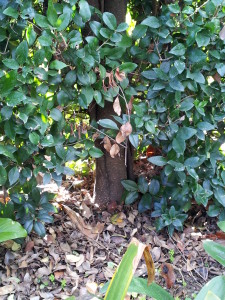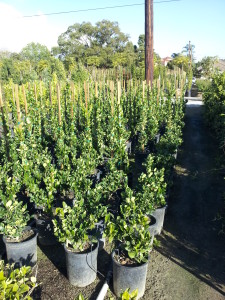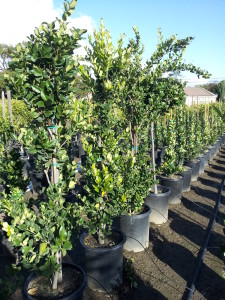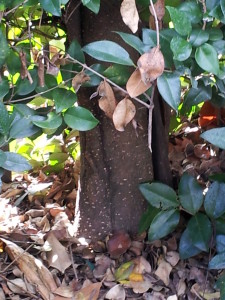Marathon is the original selling Fescue
Tabebuia ipe- Pink Trumpet Tree/
Tabebuia ipe is short for Tabebuia impetiginosa- Pink Trumpet Tree.
There are many varieties of Tabebuia available in the United States. Impetiginosa or Ipe, for short, is our most popular. Rosea is lighter pink and moving into a completely different look is Tabebuia chrysotricha which is a vibrant yellow with a distinct look.
Do a site search for Tabebuia to see great pics of what we have available.
What We Do
Neighborhood Nursery is a new business idea servicing everyone from the home gardener to the professional landscaper. We offer a full line of professional gardening supplies at exceptional prices. Neighborhood Nursery is a distributor of Plants, Pond Supplies, Irrigation Supplies, Outdoor Lighting Supplies and much more. Just about anything to care for and enjoy the outdoors.
It is important to understand that Neighborhood Nursery runs its internet operations independent of any retail store. With every order, we arrange a pick up time or we ship your items directly to you, eliminating the extra expense necessary to care of items in the retail nursery.
So how do we do offer such great pricing? By pulling plants from the growing yards and landscape material directly from the warehouse and putting them directly into your hands, we save the extra time and labor it takes to handle them in the retail yard.
Many people do not realize how much work it takes to operate a retail nursery. It is one of the highest overhead businesses you can imagine. The care of living plants is 7 days a week, requiring watering, feeding and moving the plants around. Plants can not sit on a shelf waiting to be purchased. They are living, breathing things that need care and attention, and these costs really add up.
While we are searching for our new location, Neighborhood Nursery is working with Present Perfect Nursery in Pasadena.
Note: If you have an order with Neighborhood Nursery and you see something additional in the retail store, nursery prices will be charged for the add on items.
Neighborhood Nursery with
Present Perfect Nursery
140 S Kinneloa Ave
Pasadena, CA 91107
Map to Neighborhood Nursery with Present Perfect Nursery http://goo.gl/maps/4uTD8
Availability Citrus
| Availablility Janary 1, 2013 | |||||||||||||||||
| x=available | |||||||||||||||||
| Variety | Semi Dwarf | Standard | Espalier | ||||||||||||||
| #05 | #07 | #15 | 24″ | 36″ | | | #05 | #07 | #15 | 24″ | 36″ | 48″ | 60″ | | | #07 | #15 | 24″ | |
| Grapefruit Cocktail Hybrid | x | x | – | – | – | | | x | – | – | – | – | – | – | | | – | x | – |
| Grapefruit Marsh | – | – | – | – | – | | | – | – | – | – | – | – | – | | | – | – | – |
| Grapefruit Oro Blanco | x | x | x | x | – | | | x | x | x | x | x | x | – | | | – | – | – |
| Grapefruit Rio Red | x | x | x | x | – | | | x | x | x | – | – | – | – | | | x | – | – |
| Grapefruit Star Ruby | x | x | x | – | – | | | x | x | x | – | – | – | – | | | x | – | – |
| Kumquat Meiwa | x | – | – | – | – | | | x | – | – | – | – | – | – | | | – | – | – |
| Kumquat Nagami | x | x | x | x | – | | | x | x | x | x | x | – | – | | | x | x | – |
| Kumquat Nordmann | – | x | – | – | – | | | – | – | – | – | – | – | – | | | – | – | – |
| Lemon Eureka | x | x | x | x | x | | | x | x | x | x | x | x | x | | | x | x | x |
| Lemon Meyer (Improved) | x | x | x | – | x | | | x | x | x | x | x | – | – | | | x | – | – |
| Lemon Pink Lemonade | x | x | – | – | – | | | x | x | x | – | – | – | – | | | x | – | – |
| Lemon Pomona Sweet | – | – | – | – | – | | | – | – | – | – | – | – | – | | | – | – | – |
| Lime Bearss Seedless (Tahiti) | – | – | – | – | – | | | – | – | – | – | – | – | – | | | – | – | x |
| Lime Kaffir | – | – | – | – | – | | | – | – | – | – | – | – | – | | | – | – | – |
| Lime Mexican (Key) | – | – | – | – | – | | | – | – | – | – | – | – | – | | | – | x | x |
| Lime Mexican Thornless | x | x | x | x | – | | | x | x | x | x | x | x | x | | | – | – | – |
| Lime Sweet (Palestine) | x | x | x | – | – | | | x | x | x | – | – | – | – | | | – | – | – |
| Mandarin Algerian/ Clementine | x | x | x | – | – | | | x | – | x | – | – | – | – | | | – | – | – |
| Mandarin Dancy | x | x | x | x | – | | | x | x | x | x | x | x | – | | | x | x | – |
| Mandarin Gold Nugget | x | x | x | x | – | | | x | x | x | x | | | x | – | – | |||
| Mandarin Honey | x | x | x | x | – | | | x | x | – | x | x | x | – | | | x | x | x |
| Mandarin Kishu Mini | x | x | x | x | – | | | x | x | x | x | – | – | – | | | – | x | – |
| Mandarin Page | x | x | x | x | – | | | x | x | x | x | x | x | – | | | x | x | – |
| Mandarin Pixie Tangerine | – | – | – | – | – | | | – | – | – | – | – | – | – | | | – | – | – |
| Mandarin Satsuma (Owari) | x | x | x | x | – | | | x | x | x | x | x | – | – | | | x | – | – |
| Mandarin Tango | x | x | x | x | – | | | x | x | – | x | – | – | – | | | – | – | – |
| Mandarin Yosemite Gold | – | – | – | – | – | | | – | – | – | x | x | – | – | | | x | x | x |
| Orange Cara Cara Navel (pink) | x | x | x | x | – | | | x | – | x | x | – | – | – | | | – | – | x |
| Orange Fukumoto Navel | – | – | – | – | – | | | – | – | – | – | – | – | – | | | – | – | – |
| Orange Lane Late Navel | x | – | x | – | – | | | x | x | x | x | x | – | – | | | – | – | x |
| Orange Moro Blood | x | x | x | x | – | | | x | x | x | x | x | x | – | | | – | – | – |
| Orange Sanquinelli Blood | – | – | – | – | – | | | – | – | – | – | – | – | – | | | – | – | – |
| Orange Tarocco Blood | – | – | – | – | – | | | – | – | – | – | – | – | – | | | – | – | – |
| Orange Valencia | – | – | – | – | – | | | – | – | – | – | – | – | – | | | x | x | x |
| Orange Valencia Midnight | x | x | x | x | – | | | x | x | x | x | x | x | – | | | – | – | – |
| Orange Valencia Red | – | x | x | – | – | | | – | – | x | – | – | – | – | | | – | – | – |
| Orange Washington Navel | x | x | x | x | – | | | x | x | x | x | x | x | – | | | x | x | x |
| Pummelo Chandler | x | x | – | – | – | | | x | – | – | – | – | – | – | | | – | – | x |
| Pummelo Valentine | – | x | – | – | – | | | – | – | x | – | – | – | – | | | – | – | – |
| Tangelo Minneola | x | x | x | x | – | | | x | x | x | x | x | x | – | | | x | x | x |
| Specialty Calamondin | x | – | – | – | – | | | x | – | – | – | – | – | – | | | – | – | – |
| Specialty Calamondin Variegated | – | – | – | – | – | | | – | – | – | – | – | – | – | | | – | – | – |
| Specialty Citron – Fingered “Buddha’s Hand” | – | – | – | – | – | | | – | – | – | – | – | – | – | | | – | – | – |
| Specialty Citrus Hystrix (Kaffir Lime) | x | – | – | – | – | | | x | – | – | – | – | – | – | | | – | – | – |
| Specialty Yuzu | x | x | x | x | – | | | x | x | x | x | x | x | – | | | – | – | – |
| Specialty Salad Citrus 4-5 in 1 | – | – | – | – | – | | | – | – | x | x | – | – | – | | | – | – | – |
Ligustrum texanum- Texas Privet
Ligustrum texanum- Texas Privet
One of the best hedges available.
Dark green glossy foliage.
Pest resistent.
No root problems.
Over time it can reach 20 ft tall.








Forests Absorb One Third Our Fossil Fuel Emissions
We all know the importance of trees for aesthetics, heat reduction in our environment and for global air quality.
This study confirms the importance of forests- world wide.
August 16, 2011
Forests Absorb One Third Our Fossil Fuel Emissions
The world’s established forests remove 2.4 billion tonnes of carbon per year from the atmosphere – equivalent to one third of current annual fossil fuel emissions – according to new research published today in the journal Science.
This is the first time volumes of the greenhouse gas absorbed from the atmosphere by tropical, temperate and boreal forests have been so clearly identified.
“This is really a timely breakthrough with which we can now clearly demonstrate how forests and changes in landscape such as wildfire or forest regrowth impact the removal or release of atmospheric carbon dioxide (CO2),” says CSIRO co-author of the paper: A Large and Persistent Carbon Sink in the World’s Forests, Dr Pep Canadell.
“What this research tells us is that forests play a much larger role as carbon sinks as a result of tree growth and forest expansion.”
Dr Canadell, who is also the Executive Director of the Global Carbon Project, said the international research team combined data from forest inventories, models and satellites to construct a profile of forests as major regulators of atmospheric CO2.
In addition to the large carbon sink, he said scientists now know that deforestation is responsible for emitting 2.9 billion tonnes of carbon per year – an exchange that had not been known in the past because of a lack of data. For comparison, total emissions from fossil fuels are currently above eight billion tonnes of carbon per year.
Dr Canadell said emissions from deforestation are much larger than previously thought, suggesting that the potential benefits of avoiding deforestation through the United Nations-backed Reduced Emissions from Deforestation and Degradation (REDD) scheme, are much larger than previously appreciated.
The REDD scheme aims to formulate a financial value for the carbon stored in forests.
Dr Canadell said a surprising finding was the large capacity of tropical forest re-growth to remove atmospheric CO2. Regrowth takes place following the end of logging and slash-and-burn land clearing projects. and, to a lesser extent, when new forest plantations are planted.
“We estimate that tropical forest regrowth is removing an average of 1.6 billion tonnes of carbon per year. Unfortunately, some countries have not looked on forest regrowth as a component of REDD, and so are missing a very important opportunity to gain even further climate benefits from the conservation of forests.
“Combining the uptake by established and forest re-growth plus emissions from deforestation, the world’s forests have a net effect on atmospheric CO2 equivalent to the removal of 1.1 billion tonnes of carbon every year.
“Carbon exchanges from tropical forests have the highest uncertainties in this analysis and this research has required a concerted effort to refine them to our best knowledge,” Dr Canadell said.
This work has been undertaken as part of the Australian Climate Change Science Program, funded jointly by the Department of Climate Change and Energy Efficiency, the Bureau of Meteorology and CSIRO.
The paper was co-authored by: Yude Pan, Richard Birdsey, Jingyun Fang, Richard Houghton, Pekka Kauppi, Werner A. Kurz, Oliver L. Phillips, Anatoly Shvidenko, Simon L. Lewis, Josep G. Canadell, Philippe Ciais, Robert B. Jackson, Stephen Pacala, A David McGuire, Shilong Piao, Aapo Rautiainen, Stephen Sitc and Daniel Hayes.
SOURCE: CSIRO
Trees Can Save Energy Bills
This is a great article on the importance of trees in our landscape.
Plant trees and cut your energy bills by 30%
Learn how to plant summer shade trees and a winter windbreak to save money on energy bills all year long.
By Arbor Day Foundation of The Daily Green
Did you know that just three trees properly placed around a house could save up to 30% of energy use? This is according to the U.S. Forest Service Center for Urban Forest Research. One study found that trees planted on the south and west sides of houses in Sacramento, Calif., reduced summertime electricity bills by an average of $25.
Trees provide many benefits to all of us, every day. They provide cooling shade, block cold winter winds, attract birds and other wildlife, purify the air, prevent soil erosion, clean our water and add grace and beauty to our homes and communities. In Chicago, the city’s 3.6 million trees reduce air pollution by about 890 tons annually, a $6.4 million benefit, according to the Forest Service. And in Portland, Ore., street trees growing in front of or near a house added an average of $8,870 to its sale price and reduced time on the market by nearly two days.
Planting the right trees in the right places conserves energy and reduces your energy bills, while helping to fight global warming.
Try these tips for getting the most energy- and money-saving benefit from the trees you plant on your property.
Plant deciduous trees on the east and west sides of your home
Deciduous trees (ones that lose their leaves), planted on the east and west sides, will keep your house cool in the summer and let the sun warm your home in the winter, reducing energy use, according to the Energy Department.
Large deciduous trees planted on the east, west and northwest sides of your home create soothing shade from the hot summer sun and reduce air-conditioning costs by up to 35%.
You use less energy.
The utility company uses less energy, especially at peak demand times.
Less fossil fuel is consumed by the utility to create the energy.
Less fossil-fuel consumption means lower carbon-dioxide emissions.
Plant deciduous trees to shade high-heat spots.
Trees or shrubs planted to shade air conditioners help cool a building more efficiently, using less electricity. A unit operating in the shade uses as much as 10% less electricity than the same one operating in the sun.
Plant evergreen trees to the north and northwest of your home.
After the leaves fall, the sun pours through tree branches to warm your home in winter.
The sun travels lower on the southern horizon in winter, so you’ll want to avoid planting evergreen trees on the south side of your home, where they’ll block winter sunshine.
Instead, plant an evergreen conifer windbreak on the north and northwest of your home to block cold winter winds. That could help you save up to 30% on your heating costs. Once again …
You use less energy.
The utility company uses less energy.
Less fossil fuel is consumed by the utility to create the energy.
Less fossil-fuel consumption means less carbon dioxide emissions.
The best protection from wind occurs when the windbreak is no more than the distance of one or two tree heights from the house.
The downwind side of the trees is where the most snow accumulates, so plant your windbreak at a distance equal to one or two tree heights from your rooftop and driveway if you can.
Reprinted with permission of Hearst Communications, Inc.
California Grown Show and Nursery Mart 2011
I attended the 2011 California Grown Show and Nursery Mart yesterday. The show is smaller than many I attend, but it is also more intimate. It was fun to walk the aisles and see old friends, some I have not seen for years, and make many new ones.
Our updated catalog will show several of the new varieties of dwarf shrubs and perennials, which are our specialty, that I see are coming to market this year. Dwarf Photinia and Phormiums, mimulas that will bloom longer in the heat and some interesting wattles, that are typically large trees, all staying under 5 ft tall. I’ll do an update later on these and many other plants that were on display.
What I liked about this show was that many of the nurseries were represented by their owners and upper management, people I don’t see unless I go to their shops and catch them between their other clients.
We have been 20 year customers of Weeks Roses, one of our suppliers of bare root roses. Weeks and Iselli nursery were in the news this week. They were purchased by a company that is known to be very technology oriented. Their product lines will remain the same, but efficiencies of scale will be brought into play and I am excited to see what new products can come out of this.
I also had a long conversation with Brad Fickes of Normans Nursery, one of the largest nurseries in the western US. Normans is one of our neighbors and they have been working hard remaking themselves, growing more varieties of trees and shrubs that we at Neighborhood Nursery find exciting. They are using new types of growing containers that help prevent root girdling in the cans. New varieties of plants that will fit into the small planter beds of our Southern California homes will hit the market next year. Brad was telling me about their new dwarf Photinia. I haven’t specified a Photinia-Red Tip to a project in nearly 15 years because there just isn’t any room for a 10 ft wide growing shrub in any of our homes, unless you hack it back. So this dwarf variety may be a great addition. I will plant one in a display somewhere and see what happens.
I also met a few new aquatic plant vendors. When their product hits our displays, I let you know.
Essence of Grapefruit Repels Bugs
Essence of Grapefruit Repels Bugs
Centers for Disease Control is looking for all-natural insect repellents
The Centers for Disease Control and Prevention is looking for an all-natural insect repellent, and it’s found a viable candidate.
The CDC is pushing hard to develop a completely natural insect repellent made from a chemical called nootkatone, which is found in Alaska yellow cedar trees and citrus fruit, said Marc Dolan of the CDC’s vector-borne infectious diseases laboratory in Fort Collins, Colo.
Dolan says nootkatone “is nongreasy, dries very quickly, and it has a very pleasant, citrus-y grapefruit odor to it.”
He recently demonstrated its effectiveness as a mosquito repellent, rubbing some on his hand and then sticking it into a cage containing 50 hungry mosquitoes. When he holds the treated hand near mosquitoes, they try to get away in the opposite direction as fast as they can.
Even after five minutes, Dolan has no bites on his nootkatone-treated hand.
Nootkatone is also effective against ticks, and scientists think it will work against bed bugs, head lice and other insects, too.
Moreover, nootkatone is so nontoxic you could drink it. In fact, it’s already an approved food additive, officially classed as “Generally Considered Safe.” It’s also a natural ingredient in some foods.
“If you’ve had a grapefruit, you’ve consumed some nootkatone,” Dolan says, “or drank a Squirt, for instance.”
Dolan, who is leading a CDC team to develop nootkatone, says it could be put into soaps and sunscreens, so people wouldn’t have to apply a separate bug repellent.
But that’s not all — it turns out that nootkatone could be both a repellent and an environmentally friendly pesticide. That’s because it doesn’t just repel bugs — it kills them.
Kills In Seconds
Nick Panella, another CDC biologist, recently demonstrated nootkatone’s insecticidal properties by coating the inside of a jar with the chemical and then introducing some mosquitoes. Within seconds, they all started to die.
“This stuff has incredible knock-down,” Dolan says, referring to an insecticide’s ability to kill off bugs. “It kills very, very quickly, usually within a matter of about 15 seconds.”
It kills by blocking receptors on insects’ nerve cells for a neurotransmitter called octopamine. That makes the insects hyperactive. “They basically vibrate themselves to death,” Dolan says.
Humans don’t have octopamine receptors, so that may make nootkatone safe for humans, though Dolan says scientists don’t yet know whether there’s any cross-reaction between nootkatone and adrenaline receptors. Adrenaline is the human analog of insects’ octopamine.
Dolan thinks nootkatone is likely to be so nontoxic that it could be an ingredient in “the world’s first insecticidal soap.”
“If you come in from your garden, you could shower with this soap, which would not only repel ticks and mosquitoes, or ticks that may be on you,” he says, “but ticks that may be actively feeding on you, it would cause them to detach and possibly kill them.”
Environmentally Safe
Tests so far indicate that nootkatone is highly effective as an environmental insecticide, and not just against mosquitoes. “A single application of a 2 percent solution of nootkatone will control ticks for up to 42 days at greater than 97 percent efficacy,” Dolan says.
Another advantage, he says, is that nootkatone is volatile, so it doesn’t persist very long in the environment.
“Essential oils [such as nootkatone] kill bugs and then break down and are no longer active,” the CDC scientist says. “So you don’t get a lot of soil contamination. We don’t see groundwater contamination. And we don’t have a high impact on other nontarget insects that may come into the sprayed area, such as bees and butterflies.”
Finally, nootkatone works in a completely different way from other insecticides, so mosquitoes aren’t resistant to it yet — a major problem with current insecticides. The CDC hopes the chemical will be impregnated into bed nets to reduce malaria transmission in areas where the mosquito-borne disease is endemic.
The CDC owns patents on nootkatone and has licensed them to two companies — one to develop a repellent, the other to work on insecticides. The agency isn’t looking to make much money; its interest is in seeing products get to market.
Right now nootkatone is expensive — $4,000 per kilogram for highly purified food-grade material, which is used in parts-per-million amounts as a flavoring agent. Repellents and insecticides would use a higher concentration — perhaps 2 percent. But it wouldn’t need to be as purified.
Dolan says efforts are under way to find cheaper sources of nootkatone, such as waste products from the citrus and forestry industries. In addition, a different form, called nootkatol, appears to be a lower-cost alternative for repellents. “Nootkatol is just a waste product,” he says. “Right now, that’s virtually free.”
Moringa oleifera Tree Provides Low-Cost Water Purification Method For Developing World
March 3, 2010
A low-cost water purification technique published in Current Protocols in Microbiology could help drastically reduce the incidence of waterborne disease in the developing world. The procedure, which uses seeds from the Moringa oleifera tree, can produce a 90.00% to 99.99% bacterial reduction in previously untreated water, and has been made free to download as part of access programs under John Wiley & Sons’ Corporate Citizenship Initiative.
A billion people across Asia, Africa, and Latin America are estimated to rely on untreated surface water sources for their daily water needs. Of these, some two million are thought to die from diseases caught from contaminated water every year, with the majority of these deaths occurring among children under five years of age. Michael Lea, a Current Protocols author and a researcher at Clearinghouse, a Canadian organisation dedicated to investigating and implementing low-cost water purification technologies, believes the Moringa oleifera tree could go a long way to providing a solution.
“Moringa oleifera is a vegetable tree which is grown in Africa, Central and South America, the Indian subcontinent, and South East Asia. It could be considered to be one of the world’s most useful trees,” said Lea. “Not only is it drought resistant, it also yields cooking and lighting oil, soil fertilizer, as well as highly nutritious food in the form of its pods, leaves, seeds and flowers. Perhaps most importantly, its seeds can be used to purify drinking water at virtually no cost.”
Moringa tree seeds, when crushed into powder, can be used as a water-soluble extract in suspension, resulting in an effective natural clarification agent for highly turbid and untreated pathogenic surface water. As well as improving drinkability, this technique reduces water turbidity (cloudiness) making the result aesthetically as well as microbiologically more acceptable for human consumption.
Despite its live-saving potential, the technique is still not widely known, even in areas where the Moringa is routinely cultivated. It is therefore Lea’s hope that the publication of this technique in a freely available protocol format, a first, will make it easier to disseminate the procedure to the communities that need it.
“This technique does not represent a total solution to the threat of waterborne disease,” concluded Lea. “However, given that the cultivation and use of the Moringa tree can bring benefits in the shape of nutrition and income as well as of far purer water, there is the possibility that thousands of 21st century families could find themselves liberated from what should now be universally seen as19th century causes of death and disease. This is an amazing prospect, and one in which a huge amount of human potential could be released. This is particularly mind-boggling when you think it might all come down to one incredibly useful tree.”
SOURCE: Wiley-Blackwell
